A dilute–and–shoot LC–MS/MS determination of low–dosage third–generation antipsychotics and their metabolites in urine using an ultra-short column
IF 2.8
3区 医学
Q2 BIOCHEMICAL RESEARCH METHODS
引用次数: 0
Abstract
Third–generation atypical antipsychotics, known for their enhanced efficacy and reduced side effects compared to previous generations, are now extensively utilized in the treatment of schizophrenia. Due to their chemical properties and low dosages, these drugs are present at low concentrations in urine, making it challenging to monitor medication compliance among probationers. In this study, a liquid chromatography-tandem mass spectrometric (LC–MS/MS) method was developed and validated for the determination of three third-generation antipsychotics and their main metabolites in urine. A dilute-and-shoot approach was employed for rapid urine sample preparation. All compounds were separated on an ultra-short column (2.1 × 5 mm, 1.7 μm) and detected rapidly within a span of two minutes, thereby enhancing the efficiency in handling increased workloads. The limits of detection ranged from 0.01 to 0.23 ng/mL for all compounds, with correlation coefficients exceeding 0.997. The analytical method was validated using various parameters, including selectivity, precision and accuracy, matrix effect, and stability, ensuring its reliability for forensic applications. This newly developed LC–MS/MS method was successfully applied to analyze 86 urine samples obtained from probationers undergoing antipsychotic medication. Consequently, this method proves to be useful in verifying medication compliance among probationers, and effectively managing the recent increase in the number of urine drug testing.

超短柱稀释-发射LC-MS /MS测定尿液中低剂量第三代抗精神病药物及其代谢物
与前几代相比,第三代非典型抗精神病药物以其增强的疗效和减少的副作用而闻名,目前广泛用于精神分裂症的治疗。由于这些药物的化学性质和低剂量,它们在尿液中的浓度很低,这使得监测缓刑犯的服药依从性具有挑战性。本研究建立了液相色谱-串联质谱(LC-MS /MS)测定尿液中3种第三代抗精神病药物及其主要代谢物的方法,并进行了验证。采用稀释-注射法快速制备尿样。所有化合物都在超短色谱柱(2.1 × 5 mm, 1.7 μm)上分离,并在两分钟内快速检测,从而提高了处理增加的工作量的效率。各化合物的检出限范围为0.01 ~ 0.23 ng/mL,相关系数均大于0.997。采用选择性、精密度和准确度、矩阵效应、稳定性等参数对分析方法进行了验证,确保了分析方法在法医学应用中的可靠性。本文成功地应用LC-MS /MS方法分析了86例服用抗精神病药物的缓刑犯尿液样本。因此,这种方法被证明是有用的,以核实药物依从性的缓刑,并有效地管理最近增加的尿检数量。
本文章由计算机程序翻译,如有差异,请以英文原文为准。
求助全文
约1分钟内获得全文
求助全文
来源期刊

Journal of Chromatography B
医学-分析化学
CiteScore
5.60
自引率
3.30%
发文量
306
审稿时长
44 days
期刊介绍:
The Journal of Chromatography B publishes papers on developments in separation science relevant to biology and biomedical research including both fundamental advances and applications. Analytical techniques which may be considered include the various facets of chromatography, electrophoresis and related methods, affinity and immunoaffinity-based methodologies, hyphenated and other multi-dimensional techniques, and microanalytical approaches. The journal also considers articles reporting developments in sample preparation, detection techniques including mass spectrometry, and data handling and analysis.
Developments related to preparative separations for the isolation and purification of components of biological systems may be published, including chromatographic and electrophoretic methods, affinity separations, field flow fractionation and other preparative approaches.
Applications to the analysis of biological systems and samples will be considered when the analytical science contains a significant element of novelty, e.g. a new approach to the separation of a compound, novel combination of analytical techniques, or significantly improved analytical performance.
 求助内容:
求助内容: 应助结果提醒方式:
应助结果提醒方式:


